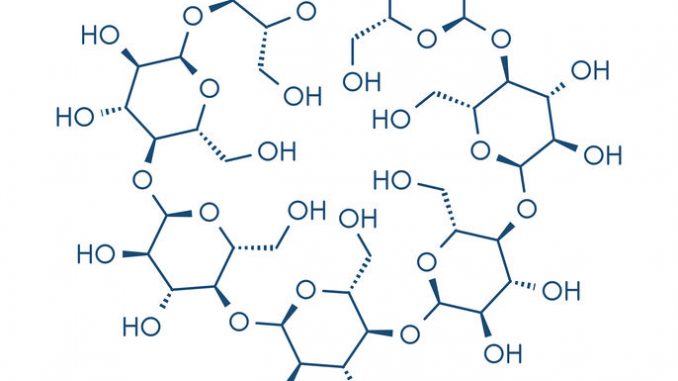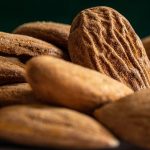
Cyclodextrins are approved for use as encapsulating agents in many food, cosmetic and pharmaceutical applications. For a number of years they were not used extensively because of prohibiting regulations and concerns over their safety.
Structure Of Cyclodextrins
The cyclodextrins (CD) are a family of cyclic oligosaccharides (oligomers) consisting of α‐D-glucopyranose units. They are classified according to the number of glucose units in their structure. There are 6 units in α-cyclodextrin, 7 units in β-cyclodextrin (BCD), and 8‐member rings, γ‐CD. They can be larger but are extremely rare and are all linked by α-(1,4) glycosidic bonds (Del Valle, 2004).
Production Of Cyclodextrins
They are derived from starch molecules, and enzymatically modified to form a hollow truncated cone shape (Hedges et al., 1995). The purification costs of α‐ and γ‐CDs are significantly higher than that of BCD, which makes the latter the choice for 97% of the applications in the market (Astray et al., 2009).
Uses Of Cyclodextrins
Nowadays the cyclodextrins are approved for use in a number of instances. In some cases they are used as food additives, for stabilization of flavours, for elimination of undesired tastes or other undesired compounds such as cholesterol and to avoid microbiological contaminations and browning reactions.
Alpha-cyclodextrin is an ideal water-soluble dietary fiber (fibre) for beverages, dairy products, bakery products, muesli bars and breakfast cereals.
In the pharmaceutical industry cyclodextrin is mainly used as a complexing agent to enhance aqueous solubility and stability of poorly soluble drugs. They are beginning to be useful in other pharmacology applications through nanoencapsulation because they can protect sensitive molecules from pH changes, heat and other rapid temperature fluctuations.
In the cosmetic industries, cyclodextrin is used similarly to increase the solubility and stability of numerous additives in a product. Hence, cyclodextrin is now widely being used in cosmetic products. The globally growing beauty consciousness and grooming trend are increasing the consumption of cosmetic products which is further expected to increase the demand for the cyclodextrin market.
Cyclodextrin improves drug bioavailability and mainly water-insoluble compounds by increasing their solubility or helping in solvation, by incorporating the molecules into their hydrophobic centre. Solubility is not only increased but so is permeability concomitantly with a reduction in toxicity. The protected molecule is also effective at much lower doses (Song et al., 2011). Cyclodextrins also stabilize labile guests against oxidation, visible or UV light, and heat degradation effects, and act as a flow-aid to produce a free-flowing powder (Del Valle 2004; Shaikh et al., 2006).
Cyclodextrins are used to modify flavours especially in reducing bitterness of certain drug preparations such as aminocetophen (paracetamol) and of limonoids.
Health Benefits And Claims
Cyclodextrins also have antidiabetic and anti-obesity effects that make them bioactive nutraceuticals and food supplements. In 2013, the European Commission verified a previous positive recommendation from EFSA for alpha-cyclodextrin. An EU assessment report stated that alpha-cyclodextrin could reduce blood sugar levels following a high starch containing meal. The new statement is contained in Commission Regulation (EU) No. 536/2013 which is a revised list of permitted health claims made on foods.
Food containing at least five grams of alpha-cyclodextrin per 50 grams of starch in a quantified portion as part of a meal may now carry a label claiming the blood-sugar-lowering effect of the product. It means that food producers can state the blood sugar lowering effect on their labeling when alpha cyclodextrin is used as a dietary fibre.
The blood-sugar-lowering effect of alpha-cyclodextrin means that it lowers the glycemic index (GI) of foods. This is important not only to diabetics: such products are digested more slowly and so keep the blood sugar level at a consistently low level. By following an appropriate diet, consumers can thus reduce the risk of cardiovascular disease, being overweight and of course, diabetes. There is also a potential positive claim for lowering blood lipids given the effects it has on cholesterol.
Other Cyclodextrins
The Food and Drug Administration (FDA) approved a cyclodextrin derivative called HPBCD (hydroxypropyl beta-cyclodextrin) which was more soluble than ordinary beta-cyclodextrin. It has a better cavity size and greater hydrophilicity (Szente and Szejtli, 2004; Yuan et al., 2008). It is now widely used as a drug carrier and the subject of a number of studies.
Health & Safety Considerations
The European Food safety Authority (EFSA) has often examined the safety and and efficacy of different cyclodextrins.
References
, , , , & (2009). A review on the use of cyclodextrins in foods. Food Hydrocolloids, 23, pp. 1631–1640 (Article).
Del Valle, E.M.M. (2004) Cyclodextrins and their uses: a review. Process Biochem. 39 pp. 1033–46.
Hedges, A.R., Shieh, W.J., Sikorski, C.T. (1995) Use of cyclodextrins for encapsulation in the use and treatment of food products. In: Encapsulation and controlled release of food ingredients. Risch, S.J., Reineccius, G.A., editors. Washington, D.C.: American Chemical Society. P 60–73.
Shaikh, J., Bhosale, R., Shinghal, R. (2006) Microencapsulation of black pepper oleoresin. FoodChem. 94 pp. 105–10.
Song, W., Yu, X., Wang, S., Blasier, R. Md C., Mao G, Shi T., Ren, W. (2011) Cyclodextrin –erythromycin complexes as a drug delivery device for orthopedic application. Int. J. Nanomed. 6 pp. 3173–86.
Szente, L., Szejtli, J. (2004) Cyclodextrins as food ingredients. Trends Food Sci. Technol. 15 pp. 137–42.
Yuan, C., Jin, Z., Li, X. (2008) Evaluation of complex forming ability of hydroxypropyl-β– cyclodextrins. Food Chem. 106 pp. 50–5.

Leave a Reply